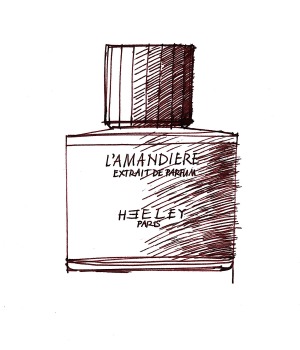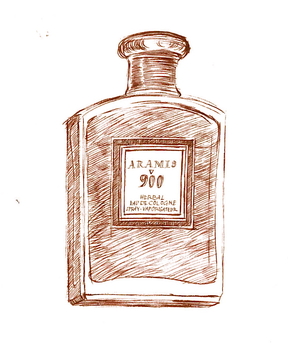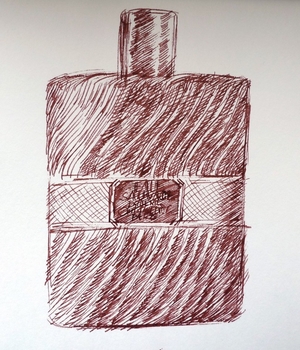Tagged With ‘floral’
Heeley
L’Amandière
19 November, 2014

Well-heeled and well-spoken, with a passing resemblance to the young Bruce Chatwin, James Heeley is a Paris-based product designer and perfumer. We’re told that he was born in Yorkshire, studied philosophy in London and then worked as a lawyer, before moving to Paris in the late 1990s, where he changed tack again and began designing vases for star French florist Christian Tortu.
Through Tortu he met Annick Goutal, the legendary pianist turned model turned independent perfumer, which must have been an inspiring introduction to the world of perfume. Heeley describes himself as a self-taught perfumer, and though he commissioned his first few fragrances he now creates the initial olfactory compositions himself.
At £170 for a 50ml bottle of ‘Extrait de parfum’ (which you can buy online from Les Senteurs), L’Amandière is breathtakingly expensive, but at least it has the grace to look like it, coming in a bottle whose surprisingly hefty weight belies its size. Its design is crisp and simple, as you’d hope from a product designer, with a simple black label and a chunky black faceted cap.
Heeley calls his latest fragrance ‘a portrait of spring’, and adds ‘I tried to include many of the scents that my girlfriend loves (including almond) and assemble them to create an imaginary, spring orchard.’ He may have intended it as a woman’s perfume, but what you smell first is light and rather refreshing combination of almond oil and fresh-cut grass – both of which have hints of bitterness (in almond’s case) and sourness (in the case of green grass), which prevents L’Amandière coming across as too floral and girly.
It does have its floral side thanks to the pastel softness of mimosa, but because the almond scent predominates in the end its associations end up reminding one more of food than flowers – though without the cloying sweetness of other food-related fragrances like vanilla or chocolate.
On a woman I think it would smell perfectly pleasant, but on a man it’s much more interesting and unusual, which is why I’m recommending it here. It has surprisingly good staying-power too, which is a good thing given how much each spray has cost you. One for the connoisseur.
Aramis
Aramis 900
9 June, 2014

Aramis is one of those mid-market brands that seems to have been around for ever, and for that reason it’s often overlooked or, worse, looked down upon. Which is, I think, a shame, because there are some classic men’s perfumes in the range.
The all-men’s brand was launched in 1964 by Estée Lauder and her husband Joseph, with the eponymous Aramis (which I’ve reviewed here) as the first fragrance in the range. Though I’d always assumed the brand and the perfume were named after the character in The Three Musketeers, legend has it that it actually commemorates an obscure town in Armenia, which these days is transliterated as Yeremes. It sounds like a leg-pull, but then we’re also told that the Lauders were working with an Armenian designer at the time by the name of Arame Yeranyan, so you never know; I’ll let you know if I can get a definitive answer out of somebody.
Whatever the truth of the matter (and the perfume industry’s relationship with historical fact can sometimes be rather shaky), Aramis was a big success, and in 1973 it begat Aramis 900. Like the original Aramis it was created by Bernard Chant, a brilliant French perfumer who loved spicy, leathery fragrances, and it’s very much along those lines.
In fact, as it’s often been pointed out, if Aramis 900 hadn’t been marketed for men, it would have worked just as well as a woman’s scent – a good example of the obvious but too rarely grasped fact that in itself perfume has no gender. Just smell Clinique’s classic woman’s perfume, Aromatics Elixir, and you’ll see what I mean: it was also created by Bernard Chant and to many people smells identical to Aramis 900.
Aramis 900 is a deep, spicy, complicated scent, which makes most contemporary offerings smell weedy and washed-out by comparison. Today you’d only expect to find a men’s fragrance smelling this rich and complex in an expensive ‘exclusive’ range like Tom Ford or Armani Privée, but when it was launched it was aimed squarely at the middle market: these were not expensive perfumes.
Like the majority of other men’s perfumes, Aramis 900 includes lemon and bergamot, but among its more persistent and powerful ingredients are carnation, orris (iris) root, geranium, oakmoss, patchouli and vetiver, as well as rosewood oil, the natural form of which comes from an increasingly threatened rainforest tree, Dalbergia nigra.
Unlike most modern men’s perfumes, though, Aramis 900 has a predominantly floral scent, which to me smells like a mix of clove-scented carnation and old-fashioned rose. Though floral fragrances were popular with Victorian men, in 20th-century western culture they came to be thought of as ‘girly’, though for no particularly logical reason as far as I can see.
Luckily that didn’t stop perfumers from using floral ingredients in men’s perfumes, but in the case of Aramis 900 those flowery scents are brilliantly disguised by all sorts of other things, including a faintly ‘dirty’ smell that adds an oddly sexy extra to the mix. The forest-floor oakmoss and vetiver also stop it smelling sweet, while the carnation (despite being a flower) gives it the same kind of peppery spiciness that you can smell in Chanel’s Egoïste.
The amazing thing, to me, is that perfumes like Aramis 900 have been so cheap for so long, but in 2009 it seems to have dawned on Estée Lauder Inc what they had on their hands, and six perfumes in the Aramis range – including Aramis 900 – were relaunched and repackaged in matching bottles. Now priced at a less mass-market £60 and titled a ‘Gentleman’s Collection’, presumably the hope is that men who liked one fragrance might go on to collect the rest. Given the quality of most men’s fragrances today I’d say that wouldn’t be a bad idea.
Christian Dior
Eau Sauvage Extrême
20 July, 2012
 What have Dior done to Eau Sauvage Extrême? I started buying it when it was pretty much what it said on the bottle – a slightly more intense and much longer-lasting version of the original Eau Sauvage, with the original’s knockout sherbert lemon and jasmine combination cranked up several extra degrees. Not something you’d want to splash around too liberally, but fun on a dreary day.
What have Dior done to Eau Sauvage Extrême? I started buying it when it was pretty much what it said on the bottle – a slightly more intense and much longer-lasting version of the original Eau Sauvage, with the original’s knockout sherbert lemon and jasmine combination cranked up several extra degrees. Not something you’d want to splash around too liberally, but fun on a dreary day.
Eau Sauvage is a scent I love, not just for its superb intrinsic quality but also for its history as the first modern men’s fragrance to have a strongly floral character, cleverly disguised by the herbal and citrus elements of a classic cologne. It was also one of the first perfumes I ever wore, so there’s an element of nostalgia to my affection too.
So when the last bottle ran out it seemed only natural to buy another – except that when I next sprayed some on it was blatantly obvious that there was something missing: namely a huge hole where the lemony part of the formula should have been. Yes, Dior (or rather Firmenich or whichever fragrance company makes the scent for them) has taken the original and reformulated it, in one of those secretive, below-the-belt moves that give the industry such a bad name.
These kinds of underhand tricks go on all the time, but it’s particularly annoying when it happens to an iconic fragrance – and particularly stupid when what’s been taken out is the citrus element that makes Eau Sauvage such a distinctive perfume in the first place; without it it’s a muted, muffled thing, with about as much appeal as a piece of damp felt.
I’ve learned my lesson, but Dior obviously haven’t learned theirs.